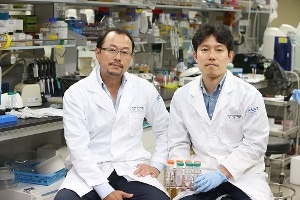Sep 27 2017
Combined photoacoustic imaging and photothermal therapy for cancer was created by Sangyong Jon, a Professor in the Department of Biological Sciences at KAIST, along with his team using Bilirubin (BR) nanoparticles.
 Professor Sangyong Jon and PhD Candidate Dong Yun Lee. Credit: KAIST
Professor Sangyong Jon and PhD Candidate Dong Yun Lee. Credit: KAIST
The properties of a bile pigment referred to as BR, which exerts powerful antioxidant and anti-inflammatory effects, were applied by the team to this research.
The team believes this research, which demonstrates high biocompatibility as well as excellent photoacoustic imaging and photothermal therapy, to be a suitable system in the field of treatment for cancer.
In the past, the research team created a PEGylated bilirubin-based nanoparticle system by joining water-insoluble BR with water-soluble Polyethylene Glycol (PEG).
This technology enabled BR exerting antioxidants yet prevented them from being collected in the body. Its safety and efficiency was identified in an animal disease model, for conditions such as asthma, inflammatory bowel disease and islet cell transportation.
Differing from earlier research techniques, this research applied the various physicochemical properties of BR to cancer treatment.
When a certain wavelength of blue light makes contact with the causative agent of jaundice, yellow BR, the agent becomes a photonic nanomaterial as it reacts to the light. This light-responsive nanomaterial can be used to treat jaundice because it enables for active excretion in infants.
Secondly, the team realized that BR is a key component of black pigment gallstones which can be frequently found in bile ducts or gall bladders under specific pathological conditions. The findings reveal that BR develops black pigment gallstones without the role of an intermediate or cation, such as copper and calcium. The research team integrated cisplatin, a platinum metal-based anticancer drug, with BR so that BR nanoparticles converted the solution color from yellow to purple.
The team also studied the possibility of cisplatin-chelated BR nanoparticles as a probe for photoacoustic images. They established that significant photoacoustic activity was displayed when it was exposed to near infrared light. Actually, the photoacoustic signal was increased greatly in tumors of animals having colorectal cancer when the nanoparticles were administered to it intravenously. The team anticipates a more accurate diagnosis of tumors via this technology.
Furthermore, the team evaluated the photothermal effects of cisplatin-chelated BR nanoparticles. The research revealed that the temperature of tumors increased by 25 °C in a matter of five minutes when they were exposed to near infrared light, because of the photothermal effect. After two weeks, their size was diminished compared to that of other groups, and in some cases the tumors were even necrotized.
Existing substances have a low biocompatibility and limitation for clinical therapy because they are artificially oriented; therefore, they might have toxicity. I am hoping that these cisplatin-chelated BR-based nanoparticles will provide a new platform for preclinical, translational research and clinical adaptation of the photoacoustic imaging and photothermal therapy.
Professor Sangyong Jon, the Department of Biological Sciences, KAIST
The research paper (Dong Yun Lee as a First Author) was published online in the distinguished journal in the field of applied chemistry, Angewandte Chemi International Edition, on September 4th. The National Research Foundation of Korea sponsored this research.